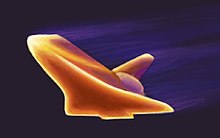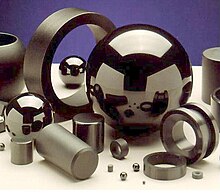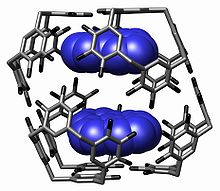Keramičko inženjerstvo — разлика између измена
. |
|||
| Ред 96: | Ред 96: | ||
Takve defektivne polikristalne koloidne strukture su osnovni elementi submikrometarske koloidne [[materials science|nauke o materijalima]], i samim tim, pružaju prvi korak u razvoju rigoroznijeg razumevanja mehanizama koji su uključeni u mikrostrukturnu evoluciju u neorganskim sistemima kao što je polikristalna keramika. |
Takve defektivne polikristalne koloidne strukture su osnovni elementi submikrometarske koloidne [[materials science|nauke o materijalima]], i samim tim, pružaju prvi korak u razvoju rigoroznijeg razumevanja mehanizama koji su uključeni u mikrostrukturnu evoluciju u neorganskim sistemima kao što je polikristalna keramika. |
||
=== Samosastavljanje === |
|||
[[File:Host Guest Complex Nanocapsule Science Year2005 Vol309 Page2037.jpg|thumbnail|An example of a supramolecular assembly.<ref>{{cite journal|journal=Science|year=2005|volume=309|doi=10.1126/science.1116579|title=Fluorescent Guest Molecules Report Ordered Inner Phase of Host Capsules in Solution|last1=Dalgarno|first1=S. J.|pmid=16179474|last2=Tucker|first2=SA|last3=Bassil|first3=DB|last4=Atwood|first4=JL|issue=5743|bibcode = 2005Sci...309.2037D|pages=2037–9 |url=https://semanticscholar.org/paper/bce9ae3d2cc7a8ab297d9b7fb73e3faa795e4954}}</ref>]] |
|||
{{rut}} |
|||
[[Self-assembly|Samosastavljanje]] is the most common term in use in the modern scientific community to describe the spontaneous aggregation of particles (atoms, molecules, colloids, micelles, etc.) without the influence of any external forces. Large groups of such particles are known to assemble themselves into [[thermodynamic]]ally stable, structurally well-defined arrays, quite reminiscent of one of the 7 [[crystal]] systems found in [[metallurgy]] and [[mineralogy]] (e.g. [[face-centred cubic]], [[body-centred cubic]], etc.). The fundamental difference in equilibrium structure is in the spatial scale of the unit cell (or [[lattice parameter]]) in each particular case. |
|||
Thus, self-assembly is emerging as a new strategy in chemical synthesis and [[nanotechnology]]. [[Molecular]] self-assembly has been observed in various [[biological]] systems and underlies the formation of a wide variety of complex biological structures. Molecular crystals, liquid crystals, colloids, micelles, [[emulsions]], phase-separated polymers, thin films and self-assembled monolayers all represent examples of the types of highly ordered structures which are obtained using these techniques. The distinguishing feature of these methods is self-organization in the absence of any external forces. |
|||
In addition, the principal mechanical characteristics and structures of biological ceramics, polymer [[Composite material|composites]], [[elastomers]], and [[cell (biology)|cellular]] materials are being re-evaluated, with an emphasis on bioinspired materials and structures. Traditional approaches focus on design methods of biological materials using conventional synthetic materials. This includes an emerging class of [[Mechanics|mechanically]] superior [[biomaterials]] based on microstructural features and designs found in nature. The new horizons have been identified in the synthesis of bioinspired materials through processes that are characteristic of biological systems in nature. This includes the nanoscale self-assembly of the components and the development of [[hierarchical]] structures.<ref name="K"/><ref name="L"/><ref name=ariga>{{Cite journal | doi = 10.1088/1468-6996/9/1/014109| pmid = 27877935| title = Challenges and breakthroughs in recent research on self-assembly| journal = Science and Technology of Advanced Materials| volume = 9| issue = 1| pages = 014109| year = 2008| last1 = Ariga | first1 = K. | last2 = Hill | first2 = J. P. | last3 = Lee | first3 = M. V. | last4 = Vinu | first4 = A. | last5 = Charvet | first5 = R. | last6 = Acharya | first6 = S. | bibcode = 2008STAdM...9a4109A|pmc=5099804}}</ref> |
|||
== Reference == |
== Reference == |
||
{{Reflist|}} |
{{Reflist|}} |
||
== Literatura == |
|||
{{refbegin|30em}} |
|||
* {{cite book|doi=10.1117/12.405270|title=Proceedings of SPIE|chapter=Transparent ceramics for armour and EM window applications|year=2000|last1=Patel|first1=Parimal J.|volume=4102|pages=1–14|series=Inorganic Optical Materials II|chapter-url=https://zenodo.org/record/1235592}} |
|||
* Harris, D.C., "Materials for Infrared Windows and Domes: Properties and Performance", SPIE PRESS Monograph, Vol. PM70 (Int. Society of Optical Engineers, Bellingham WA, 2009) {{ISBN|978-0-8194-5978-7}} |
|||
* {{cite book |first=C.J. |last=Brinker |author2=Scherer, G.W. |title=Sol-Gel Science: The Physics and Chemistry of Sol-Gel Processing |publisher=Academic Press |year=1990 |isbn=978-0-12-134970-7}} |
|||
* {{cite journal |first=L.L. |last=Hench |author2=West, J.K. |title=The Sol-Gel Process |journal=Chemical Reviews |volume=90 |page=33 |year=1990 |doi=10.1021/cr00099a003}} |
|||
* {{cite book |first=L. |last=Klein |title=Sol-Gel Optics: Processing and Applications |publisher=Springer Verlag |year=1994|url=https://books.google.com/?id=wH11Y4UuJNQC&printsec=frontcover|isbn=978-0-7923-9424-2}} |
|||
* {{cite journal |last= Schuh|first=Christopher |author2=Nieh, T.G. |year=2002|doi=10.1557/PROC-740-I1.8|title=Hardness and Abrasion Resistance of Nanocrystalline Nickel Alloys Near the Hall-Petch Breakdown Regime|url=http://www.dtic.mil/dtic/tr/fulltext/u2/p014240.pdf |journal=Mater. Res. Soc. Symp. Proc. |volume=740}} |
|||
* {{Cite book |last1 = Chiang|first1 = Yet-Ming |last2 = Birnie|first2 = Dunbar P. |last3 = Kingery|first3 = W. David |title = Physical Ceramics: Principles for Ceramic Science and Engineering |publisher = John Wiley & Sons |date = May 1996 |location = |url = |doi = |id = |isbn = 0-471-59873-9}} |
|||
*{{cite book |last = Green |first = D.J. |author2=Hannink, R. |author3=Swain, M.V. |year = 1989 |title = Transformation Toughening of Ceramics |location = Boca Raton |publisher = CRC Press |isbn = 0-8493-6594-5 }} |
|||
* {{cite book |last = German |first = R.M. |year = 1996 |title = Sintering Theory and Practice |publisher = John Wiley & Sons, Inc |isbn = 0-471-05786-X }} |
|||
* {{Cite book |last1 = Kang|first1 = Suk-Joong L. |title = Sintering |publisher = [[Elsevier]], Butterworth Heinemann |year = 2005 |edition = 1st |location = Oxford |url = |doi = |id = |isbn = 0-7506-6385-5}} |
|||
{{refend}} |
|||
== Spoljašnje veze == |
== Spoljašnje veze == |
||
Верзија на датум 2. јун 2020. у 01:38



Keramičko inženjerstvo je nauka i tehnologija stvaranja predmeta od neorganskih, nemetalnih materijala. To se postiže dejstvom toplote, ili na nižim temperaturama korišćenjem reakcije precipitacije iz hemijskih rastvora visoke čistoće. Ovaj termin obuhvata pročišćavanje sirovina, proučavanje i proizvodnju odgovarajućih hemijskih jedinjenja, njihovo oblikovanje u komponente i proučavanje njihove strukture, sastava i svojstava.
Keramički materijali mogu imati kristalnu ili delimično kristalnu strukturu, sa dugometnim redosledom u atomskoj skali. Staklena keramika može imati amorfnu ili staklastu strukturu, sa ograničenom ili kratkometnom atomskom uređenosti. Ona se formira iz rastopljene mase koja je očvrsnuta hlađenjem, formirana i sazrela dejstvom toplote, ili se hemijski sintetišu na niskim temperaturama, na primer koristeći hidrotermalnu ili sol-gel sintezu.
Poseban karakter keramičkih materijala omogućava mnoge primene u inženjerstvu materijala, elektrotehnici, hemijskom i mašinskom inženjerstvu. Kako je keramika otporna na toplotu, ona se može koristiti za mnoge zadatke za koje materijali poput metala i polimera nisu pogodni. Keramički materijali se koriste u širokom opsegu industrije, uključujući rudarstvo, vazduhoplovstvo, medicinu, rafinerije, prehrambenu i hemijsku industriju, nauku o pakovanju, elektroniku, industrijsku i prenosnu električnu energiju i vođeni prenos svetlosnih talasa.[1]
Istorija
Reč „keramika” potiče od grčke reči κεραμικός (keramikos) što znači grnčarstvo. Povezana je sa starijim korenom indoevropskog jezika „goreti”.[2] „Keramika” se može koristiti kao imenica u jednini za označavanje keramičkog materijala ili proizvoda keramičke izrade, ili kao pridev. Množina „keramike” se može koristiti za označavanje izrade stvari od keramičkih materijala. Keramičko inženjerstvo, poput mnogih nauka, evoluiralo je iz drugačije discipline po današnjim standardima. Inženjerstvo nauke o materijalima se grupiše sa keramičkim inženjerstvom do današnjeg dana.

Abraham Darbi je prvi je koristio koks 1709. godine u Šropširu u Engleskoj da bi poboljšao prinos postupka topljenja. Koks se danas široko koristi za proizvodnju karbidne keramike. Grnčar Džosaja Vedžvud otvorio je prvu modernu fabriku keramike u gradu Stouk na Trentu, u Engleskoj, 1759. godine. Austrijski hemičar Karl Jozef Bajer, koji je radio u tekstilnoj industriji u Rusiji, razvio je proces odvajanja alumine iz boksitne rude 1888. godine. Bajerov postupak i dalje se koristi za pročišćavanje alumine za keramičku i aluminijumsku industriju. Braća Pjer i Žak Kiri otkrili su piezoelektričnost u Rošelovoj soli oko 1880. godine. Piezoelektričnost je jedno od ključnih svojstava elektrokeramike.
E. G. Ačeson je 1893. zagrejao mešavinu koksa i gline i izumeo karborundum, odnosno sintetični silicijum karbid. Anri Moasan je takođe sintetisao SiC i volfram karbid u svojoj elektrolučnoj peći u Parizu otprilike u isto vreme kada je Ačeson. Karl Šreter je koristio sinterovanje u tečnoj fazi da bi vezao ili „cementirao” Moasanove volfram karbidne čestice sa kobaltom 1923. godine u Nemačkoj. Tvrdim metalom cementirane ivice od karbida uveliko povećavaju trajnost očvrslog čeličnog alata za rezanje. Valter Nernst je razvijao kubno stabilizovani cirkonijum tokom 1920-ih u Berlinu. Ovaj materijal se koristi kao kiseonični senzor u izduvnim sistemima. Glavno ograničenje upotrebe keramike u inženjerstvu je krkost.[1]
Teorija hemijske obrade
Mikrostrukturna uniformnost
Pri obradi fine keramike, neregularne veličine čestica i oblici u tipičnom prahu često dovode do nejednakih morfologija pakovanja što rezultira promenom gustine pakovanja u kompaktiranom prahu. Nekontrolirana aglomeracija praha zbog atraktivnih van der Valsovih sila takođe može da stvori mikrostrukturne nehomogenosti.[3][4]
Diferencijalni naponi koji nastaju kao rezultat neravnomernog skupljanja tokom sušenja direktno su povezani sa brzinom kojom se rastvarač može ukloniti i stoga zavise od distribucije poroznosti. Takvi naponi su povezani sa prelaskom iz plastičnog u krhko stanje u konsolidovanim telima[5] i mogu dovesti do širenja pukotina u nerastopljenom telu, ako se ne otklone.
Pored toga, bilo kakve fluktuacije u gustini pakovanja u kompaktima dok se pripremaju za peć često se pojačavaju tokom procesa sinterovanja, što rezultira nehomogenim zgušnjavanjem.[6][7] Pokazano je da neke pore, i drugi strukturni defekti povezani sa varijacijama gustine, imaju štetnu ulogu u procesu sinterovanja tako što rastu i na taj način ograničavaju gustinu krajnjih tačaka.[8] Za diferencijalne napone koji nastaju pri nehomogenom zgušnjavanju takođe je pokazano da rezultiraju u širenju unutrašnjih pukotina, tako da postaju nedostaci koji ograničavaju jačinu.[9]
Stoga je poželjno da se materijal obrađuje na takav način da je fizički ujednačen u pogledu raspodele komponenati i poroznosti, pre nego da se koristi raspodela veličina čestica koje će maksimizirati gustinu. Sadržaj ravnomerno dispergovanog sklopa čestica koje imaju snažne interakcije u suspenziji zahteva potpunu kontrolu nad interakcijama među česticama. Monodisperzni koloidi pružaju tu mogućnost.[10]
Na primer, monodisperzni praškovi koloidnog silike se mogu dovoljno stabilizovati da se obezbedi visok stepen uređenosti u koloidnom kristalnom ili polikristalnom koloidnom čvrstom materijalu koji nastaje agregacijom. Stepen uređenosti je ograničen vremenom i prostorom koji su dozvoljeni za uspostavljanje korelacija većeg dometa.[11][12]
Takve defektivne polikristalne koloidne strukture su osnovni elementi submikrometarske koloidne nauke o materijalima, i samim tim, pružaju prvi korak u razvoju rigoroznijeg razumevanja mehanizama koji su uključeni u mikrostrukturnu evoluciju u neorganskim sistemima kao što je polikristalna keramika.
Samosastavljanje

Један корисник управо ради на овом чланку. Молимо остале кориснике да му допусте да заврши са радом. Ако имате коментаре и питања у вези са чланком, користите страницу за разговор.
Хвала на стрпљењу. Када радови буду завршени, овај шаблон ће бити уклоњен. Напомене
|
Samosastavljanje is the most common term in use in the modern scientific community to describe the spontaneous aggregation of particles (atoms, molecules, colloids, micelles, etc.) without the influence of any external forces. Large groups of such particles are known to assemble themselves into thermodynamically stable, structurally well-defined arrays, quite reminiscent of one of the 7 crystal systems found in metallurgy and mineralogy (e.g. face-centred cubic, body-centred cubic, etc.). The fundamental difference in equilibrium structure is in the spatial scale of the unit cell (or lattice parameter) in each particular case.
Thus, self-assembly is emerging as a new strategy in chemical synthesis and nanotechnology. Molecular self-assembly has been observed in various biological systems and underlies the formation of a wide variety of complex biological structures. Molecular crystals, liquid crystals, colloids, micelles, emulsions, phase-separated polymers, thin films and self-assembled monolayers all represent examples of the types of highly ordered structures which are obtained using these techniques. The distinguishing feature of these methods is self-organization in the absence of any external forces.
In addition, the principal mechanical characteristics and structures of biological ceramics, polymer composites, elastomers, and cellular materials are being re-evaluated, with an emphasis on bioinspired materials and structures. Traditional approaches focus on design methods of biological materials using conventional synthetic materials. This includes an emerging class of mechanically superior biomaterials based on microstructural features and designs found in nature. The new horizons have been identified in the synthesis of bioinspired materials through processes that are characteristic of biological systems in nature. This includes the nanoscale self-assembly of the components and the development of hierarchical structures.[11][12][14]
Reference
- ^ а б Kingery, W.D., Bowen, H.K., and Uhlmann, D.R., Introduction to Ceramics, p. 690 (Wiley-Interscience, 2nd Edition, 2006)
- ^ von Hippel; A. R. (1954). „Ceramics”. Dielectric Materials and Applications. Technology Press (M.I.T.) and John Wiley & Sons. ISBN 978-1-58053-123-8.
- ^ Onoda, G.Y. Jr.; Hench, L.L., ур. (1979). Ceramic Processing Before Firing. New York: Wiley & Sons.
- ^ Aksay, I.A.; Lange, F.F.; Davis, B.I. (1983). „Uniformity of Al2O3-ZrO2 Composites by Colloidal Filtration”. J. Am. Ceram. Soc. 66 (10): C–190. doi:10.1111/j.1151-2916.1983.tb10550.x.
- ^ Franks, G.V.; Lange, F.F. (1996). „Plastic-to-Brittle Transition of Saturated, Alumina Powder Compacts”. J. Am. Ceram. Soc. 79 (12): 3161. doi:10.1111/j.1151-2916.1996.tb08091.x.
- ^ Evans, A.G.; Davidge, R.W. (1969). „Strength and fracture of fully dense polycrystalline magnesium oxide”. Phil. Mag. 20 (164): 373. Bibcode:1969PMag...20..373E. doi:10.1080/14786436908228708.
- ^ Evans, A.G.; Davidge, R.W. (1970). „Strength and fracture of fully dense polycrystalline magnesium oxide”. J. Mater. Sci. 5 (4): 314. Bibcode:1970JMatS...5..314E. doi:10.1007/BF02397783.
- ^ Lange, F.F.; Metcalf, M. (1983). „Processing-Related Fracture Origins in Al2O3/ZrO2 Composites II: Agglomerate Motion and Crack-like Internal Surfaces Caused by Differential Sintering”. J. Am. Ceram. Soc. 66 (6): 398. doi:10.1111/j.1151-2916.1983.tb10069.x.
- ^ Evans, A.G. (1987). „Considerations of Inhomogeneity Effects in Sintering”. J. Am. Ceram. Soc. 65 (10): 497. doi:10.1111/j.1151-2916.1982.tb10340.x.
- ^ Mangels, J.A.; Messing, G.L. (1984). „Microstructural Control Through Colloidal Consolidation”. Advances in Ceramics: Forming of Ceramics. 9: 94.
- ^ а б Whitesides, G.M.; et al. (1991). „Molecular Self-Assembly and Nanochemistry: A Chemical Strategy for the Synthesis of Nanostructures”. Science. 254 (5036): 1312—9. Bibcode:1991Sci...254.1312W. PMID 1962191. doi:10.1126/science.1962191.
- ^ а б Dubbs D. M; Aksay I.A. (2000). „Self-Assembled Ceramics”. Annu. Rev. Phys. Chem. 51: 601—22. Bibcode:2000ARPC...51..601D. PMID 11031294. doi:10.1146/annurev.physchem.51.1.601.
- ^ Dalgarno, S. J.; Tucker, SA; Bassil, DB; Atwood, JL (2005). „Fluorescent Guest Molecules Report Ordered Inner Phase of Host Capsules in Solution”. Science. 309 (5743): 2037—9. Bibcode:2005Sci...309.2037D. PMID 16179474. doi:10.1126/science.1116579.
- ^ Ariga, K.; Hill, J. P.; Lee, M. V.; Vinu, A.; Charvet, R.; Acharya, S. (2008). „Challenges and breakthroughs in recent research on self-assembly”. Science and Technology of Advanced Materials. 9 (1): 014109. Bibcode:2008STAdM...9a4109A. PMC 5099804
 . PMID 27877935. doi:10.1088/1468-6996/9/1/014109.
. PMID 27877935. doi:10.1088/1468-6996/9/1/014109.
Literatura
- Patel, Parimal J. (2000). „Transparent ceramics for armour and EM window applications”. Proceedings of SPIE. Inorganic Optical Materials II. 4102. стр. 1—14. doi:10.1117/12.405270.
- Harris, D.C., "Materials for Infrared Windows and Domes: Properties and Performance", SPIE PRESS Monograph, Vol. PM70 (Int. Society of Optical Engineers, Bellingham WA, 2009) ISBN 978-0-8194-5978-7
- Brinker, C.J.; Scherer, G.W. (1990). Sol-Gel Science: The Physics and Chemistry of Sol-Gel Processing. Academic Press. ISBN 978-0-12-134970-7.
- Hench, L.L.; West, J.K. (1990). „The Sol-Gel Process”. Chemical Reviews. 90: 33. doi:10.1021/cr00099a003.
- Klein, L. (1994). Sol-Gel Optics: Processing and Applications. Springer Verlag. ISBN 978-0-7923-9424-2.
- Schuh, Christopher; Nieh, T.G. (2002). „Hardness and Abrasion Resistance of Nanocrystalline Nickel Alloys Near the Hall-Petch Breakdown Regime” (PDF). Mater. Res. Soc. Symp. Proc. 740. doi:10.1557/PROC-740-I1.8.
- Chiang, Yet-Ming; Birnie, Dunbar P.; Kingery, W. David (мај 1996). Physical Ceramics: Principles for Ceramic Science and Engineering. John Wiley & Sons. ISBN 0-471-59873-9.
- Green, D.J.; Hannink, R.; Swain, M.V. (1989). Transformation Toughening of Ceramics. Boca Raton: CRC Press. ISBN 0-8493-6594-5.
- German, R.M. (1996). Sintering Theory and Practice. John Wiley & Sons, Inc. ISBN 0-471-05786-X.
- Kang, Suk-Joong L. (2005). Sintering (1st изд.). Oxford: Elsevier, Butterworth Heinemann. ISBN 0-7506-6385-5.
